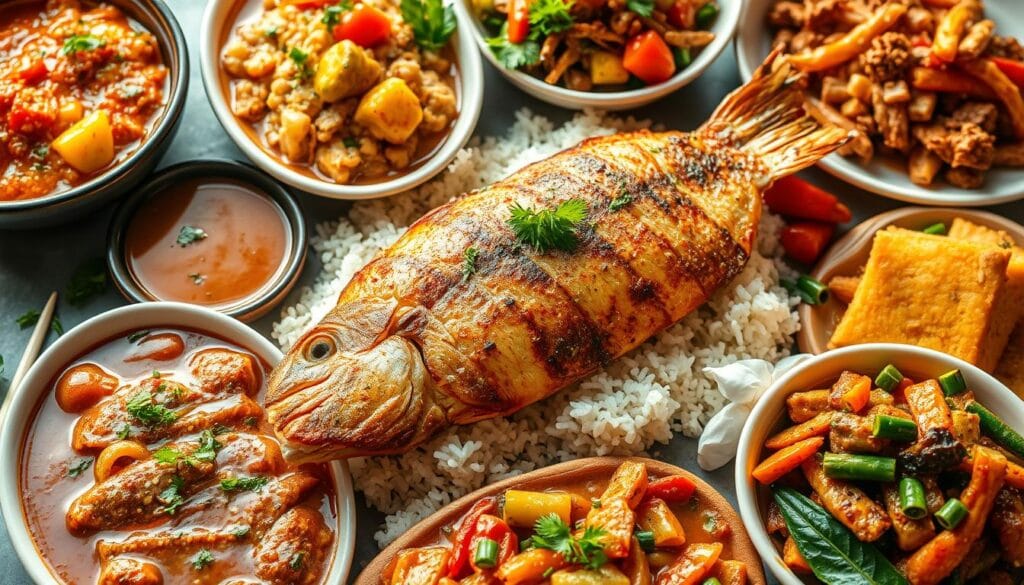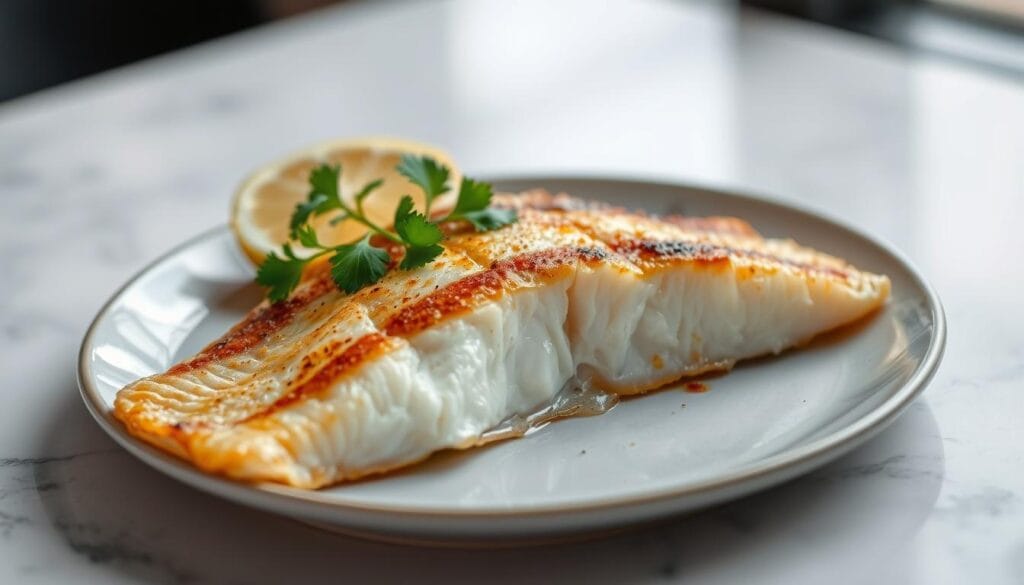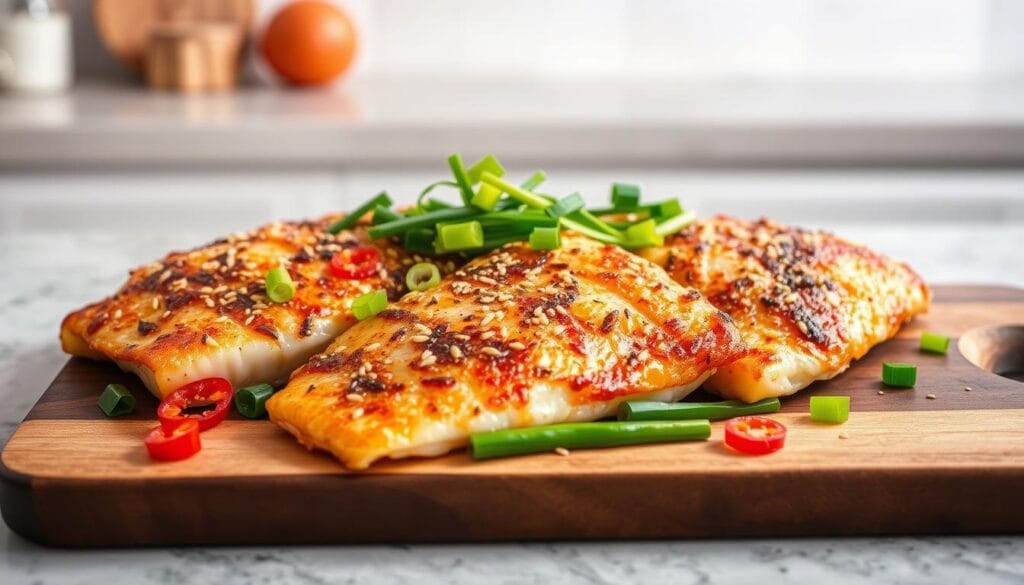Looking for a tasty and healthy seafood dish? You’re in the right spot! Baking tilapia is a great way to cook this mild fish. Adding Asian flavors makes it even better. With a few easy ingredients and techniques, you can make a dish that will wow everyone.
This guide will teach you how to make Asian-style baked tilapia. It’s both delicious and good for you. You’ll find out the key ingredients, how to prepare it, and some popular asian tilapia recipes. This will make it a favorite in your kitchen.
Table of Contents
Key Takeaways
- Learn how to bake tilapia to perfection
- Discover the key ingredients for Asian-style flavor
- Explore popular recipes to inspire your cooking
- Get tips on preparing tilapia for maximum flavor
- Understand the benefits of baking tilapia
The Appeal of Asian Flavors with Tilapia
Asian flavors can make tilapia both healthy and tasty. You can make easy asian tilapia recipes by mixing this mild fish with Asian seasonings. This mix creates a dish that’s full of flavor and nutrients.
Health Benefits of Tilapia
Tilapia is great for a healthy meal. It’s low in fat but high in protein. It also has omega-3s, vitamins, and minerals that are good for your heart and health.
Why Asian Seasonings Enhance Mild Fish
Seasonings like soy sauce, ginger, and garlic boost tilapia’s flavor. They add depth and match the fish’s mild taste. This way, you can make easy asian tilapia recipes that are tasty and good for you.
Essential Ingredients for Perfect Asian Tilapia
To make the perfect Asian-style baked tilapia, you need to know the key ingredients. You’ll need a few important elements to get that authentic Asian taste.
Key Asian Sauces and Seasonings
Asian food is known for its bold flavors. These come from various sauces and seasonings. The most important ones are:
Soy Sauce, Fish Sauce, and Oyster Sauce
Soy sauce, fish sauce, and oyster sauce are the heart of many Asian dishes. Soy sauce gives a salty, umami taste. Fish sauce adds a strong flavor. Oyster sauce brings a rich, sweet taste.
Essential Aromatics and Spices
Ginger and garlic are key in Asian cooking. They add warmth and depth to the tilapia. Spices like star anise and cinnamon also add to the flavor.
Sweeteners and Acidic Components
To balance the flavors, you need sweeteners like honey or sugar. And acidic components like rice vinegar or lime juice. They help make the flavors of your Asian-style baked tilapia harmonious.
Selecting Quality Tilapia Fillets
The quality of your tilapia fillets is crucial. Here are some things to consider:
Fresh vs. Frozen Considerations
Both fresh and frozen tilapia work well for baking. Fresh tilapia has a firmer texture. Frozen tilapia is often easier to find and can be just as tasty if thawed right.
Sustainability and Sourcing
Choose tilapia that’s sustainably sourced. Look for certifications like the Aquaculture Stewardship Council (ASC) or the Best Aquaculture Practices (BAP). This ensures your tilapia is good for the environment.
Preparation Techniques for Tilapia
To get the best results with your Asian-style baked tilapia, proper preparation is key. This involves several steps. These steps ensure your dish is flavorful and cooked perfectly.
Cleaning and Preparing the Fish
Begin by rinsing your tilapia fillets under cold water. Then, pat them dry with paper towels. This step is crucial for removing impurities and helping the marinade stick to the fish.
Effective Marinating Methods
Marinating is a critical step in infusing your tilapia with bold Asian flavors. You can choose between quick marinades for a fast flavor boost or overnight infusion for deeper flavor penetration.
Quick Marinades
For a quick marinade, mix your chosen Asian-inspired ingredients like soy sauce, ginger, and garlic. Coat the tilapia fillets. Let them sit for at least 30 minutes to absorb the flavors.
Overnight Flavor Infusion
For a more intense flavor, marinate the tilapia overnight in the refrigerator. This allows the fish to fully absorb the complex flavors, resulting in a more delicious dish.
Setting Up Your Baking Dish
Before baking, prepare your baking dish by lining it with parchment paper or lightly greasing it with oil. Arrange the marinated tilapia fillets in a single layer, ensuring they don’t overlap. This setup helps in even cooking and prevents the fish from sticking to the dish.
By following these preparation techniques, you’ll be on your way to creating one of the best Asian tilapia recipes. Whether you’re in a hurry or have time to spare, these methods will help you achieve a deliciously baked tilapia with Asian flavors.
Popular Asian Tilapia Recipes to Try at Home
Tilapia is perfect for Asian flavors because of its light taste and soft texture. You can make authentic Asian tilapia recipes at home. This will impress your family and friends with little effort.
Ginger-Soy Glazed Tilapia
This recipe mixes soy sauce’s savory taste with ginger’s spicy kick. It makes a glaze that goes great with tilapia. It’s a simple yet elegant dish that’s sure to be a hit.
Ingredients List
- 4 tilapia fillets
- 1/4 cup soy sauce
- 2 tablespoons honey
- 2 tablespoons grated fresh ginger
- 2 cloves garlic, minced
- 2 tablespoons olive oil
- 1 tablespoon rice vinegar
- 1 teaspoon sesame oil
- 1/4 teaspoon red pepper flakes (optional)
- Sesame seeds and chopped green onions for garnish
Preparation Method
Preheat your oven to 400°F (200°C). Mix soy sauce, honey, ginger, garlic, olive oil, rice vinegar, sesame oil, and red pepper flakes (if using) in a bowl. Place the tilapia in a baking dish and brush the glaze on both sides. Bake for 12-15 minutes until it’s flaky. Top with sesame seeds and green onions before serving.
Thai-Inspired Coconut Curry Tilapia
This recipe brings Thai coconut curry’s rich flavors to your dinner. It’s both comforting and exotic, great for any occasion.
Ingredients List
- 4 tilapia fillets
- 1 can (14 oz) coconut milk
- 2 tablespoons Thai red curry paste
- 2 cloves garlic, minced
- 1 tablespoon grated fresh ginger
- 1 tablespoon fish sauce
- 1 tablespoon lime juice
- 1/4 cup chopped fresh cilantro
- Salt and pepper to taste
- 1 tablespoon coconut oil
Preparation Method
Heat coconut oil in a large skillet over medium heat. Add curry paste and cook, stirring constantly, for 1-2 minutes. Pour in coconut milk and stir. Bring to a simmer, then lower the heat. Add garlic, ginger, fish sauce, and lime juice, stirring to mix. Place tilapia in the sauce and simmer, covered, for 8-10 minutes. Season with salt and pepper, and garnish with cilantro before serving.
Step-by-Step Baking Process
To bake tilapia with Asian flavors, follow these steps. Baking tilapia needs the right temperature and timing. This ensures it turns out perfectly.
Preheating and Oven Setup
First, preheat your oven to 400°F (200°C). This temperature cooks the fish evenly and keeps it moist. Make sure your baking dish is safe for the oven and big enough for the tilapia fillets.
Timing and Temperature Guidelines
The cooking time for tilapia varies based on its thickness. Here are some guidelines:
| Fillet Thickness | Cooking Time | Internal Temperature |
|---|---|---|
| Thin Fillets (1/4 inch) | 8-10 minutes | 145°F (63°C) |
| Thicker Cuts (1/2 inch) | 12-15 minutes | 145°F (63°C) |
For Thin Fillets
Thin tilapia fillets cook fast. Check for doneness after 8 minutes by flaking the fish with a fork.
For Thicker Cuts
Thicker tilapia fillets need more time. Make sure they reach 145°F (63°C) for safety and flavor.
Visual Cues for Perfectly Cooked Fish
A perfectly cooked tilapia flakes easily and looks opaque. Visual inspection is crucial. The fish should not look raw. The edges should be slightly firm.
By following these steps, you can make a delicious baked tilapia dish. Whether it’s a simple soy-ginger glazed tilapia or a complex Thai-inspired coconut curry tilapia, baking is key to a great taste.
Regional Variations of Asian Tilapia Recipes

Asian tilapia recipes show off the diversity of different regions. You can try new flavors by using local ingredients and cooking methods.
Korean Gochujang-Glazed Tilapia
Korean food is known for its bold tastes, thanks to gochujang, a spicy chili paste. To make Korean Gochujang-Glazed Tilapia, mix gochujang with soy sauce, brown sugar, garlic, and sesame oil. Let the tilapia marinate for 30 minutes before baking.
This dish is a mix of sweet, spicy, and savory flavors. It’s sure to wow your guests.
Japanese Miso-Butter Tilapia
Japanese cooking is simple yet elegant. For Japanese Miso-Butter Tilapia, mix miso paste with butter, soy sauce, and sake (if you have it). Spread this on the tilapia before baking.
The miso adds a deep umami taste, while the butter keeps the fish moist and soft.
Vietnamese Lemongrass and Lime Tilapia
Vietnamese food often uses fresh herbs and citrus. To make Vietnamese Lemongrass and Lime Tilapia, marinate the tilapia in lemongrass, lime juice, fish sauce, and chili flakes. Bake until it’s done.
This dish is light, refreshing, and full of bright flavors.
| Region | Key Ingredients | Flavor Profile |
|---|---|---|
| Korean | Gochujang, soy sauce, brown sugar | Spicy, sweet, savory |
| Japanese | Miso paste, butter, soy sauce | Rich, umami, tender |
| Vietnamese | Lemongrass, lime juice, fish sauce | Fresh, citrusy, spicy |
These Asian tilapia recipes take you on a culinary trip across cultures. You can mix and match these flavors to make your own easy Asian tilapia recipes at home.
Complementary Side Dishes for a Complete Meal
Adding traditional Asian sides to your baked tilapia can make your meal better. Choose sides that match the flavors of your tilapia. They should also add texture and nutrients.
Traditional Rice and Noodle Pairings
Asian dishes often feature rice or noodles. They’re great with baked tilapia. Try steamed jasmine rice for a light taste. Or, go for stir-fried noodles with veggies for a crunchy bite. Here are some good choices:
- Sushi rice with sesame seeds
- Stir-fried rice noodles with vegetables
- Coconut rice for a creamy side
Vegetable Sides That Balance the Dish
Vegetables are key for a balanced meal. They can be cooked in many ways to match your tilapia’s taste. Think about grilled bok choy or steamed broccoli with soy sauce. Other great options are:
- Roasted Brussels sprouts with garlic
- Sauteed spinach with ginger
- Stir-fried bell peppers with chili flakes
Quick Pickled Accompaniments for Contrast
Quick pickled veggies offer a tangy contrast to rich tilapia. Make a quick pickle with thinly sliced cucumbers or carrots in vinegar, sugar, and salt. These pickles are quick to make and add a nice crunch.
With these sides, you can make a healthy and quick Asian tilapia meal. It’s both filling and good for you. Try different mixes to find your top picks.
Troubleshooting Common Issues When Baking Tilapia

To make sure your Asian-style baked tilapia is tasty and moist, you need to fix common baking problems. Baking tilapia can be tricky, but with the right steps, you can make a healthy and tasty dish.
Preventing Dry, Overcooked Fish
One big problem with baking tilapia is getting it dry and overcooked. To avoid this, don’t overbake the fish. It should be cooked to an internal temperature of 145°F to 150°F. A meat thermometer is a great tool to check if it’s done right.
Also, keep the tilapia moist by covering it with foil while baking or marinating it first. This helps keep its moisture in.
- Check the thickness of your tilapia fillets and adjust baking time accordingly.
- Use a marinade that includes ingredients like soy sauce, ginger, and garlic to enhance flavor and moisture.
Balancing Strong Asian Flavors
Asian flavors can be strong and overpowering if not balanced right. To get a balanced taste, balance the strong Asian flavors with other ingredients. For example, if you’re using a lot of soy sauce or gochujang, add a squeeze of fresh lime juice or some cilantro.
“The key to a great dish is balance. Too much of any single flavor can overpower the dish.”
Adjusting Recipes for Different Fillet Sizes
Different sizes of tilapia fillets need different baking times. Adjust your recipe based on the size of your fillets. Thicker fillets take longer, while thinner ones cook faster. A good rule is to bake tilapia for 10-12 minutes per inch of thickness.
- Measure the thickness of your tilapia fillets.
- Adjust the baking time based on the thickness.
- Keep an eye on the fish as it approaches the recommended baking time.
Health Benefits of Asian-Style Baked Tilapia
Tilapia baked with Asian seasonings is a healthy and tasty meal. It combines tilapia’s nutritional benefits with the health benefits of Asian herbs and spices.
Nutritional Profile of Tilapia
Tilapia is a low-fat, high-protein fish full of vitamins like vitamin D and selenium. It’s great for those watching their fat intake but still want quality protein. Its mild taste is perfect for the bold flavors of Asian cuisine.
Benefits of Asian Herbs and Spices
Asian herbs and spices, like ginger, garlic, and lemongrass, add flavor and health benefits to tilapia. They are known for their anti-inflammatory properties. Adding them to your tilapia recipe makes it both delicious and nutritious.
Caloric Comparison to Other Cooking Methods
Baking tilapia is a low-calorie cooking method that keeps the fish moist and flavorful. It’s much lower in calories than frying. This makes Asian-style baked tilapia a healthier choice than fried fish, fitting well with the balance and nutrition of traditional asian tilapia dishes.
Conclusion
You now have the tools and inspiration to make delicious Asian-style baked tilapia at home. By using key ingredients and mastering cooking techniques, you can improve your cooking skills. This will make your meals more enjoyable.
Trying out different Asian tilapia recipes lets you find new flavors and styles. Whether you like a ginger-soy glaze or a Thai coconut curry, tilapia is perfect for experimenting. It’s a great way to express your creativity in the kitchen.
Keep exploring Asian-style baked tilapia and don’t be afraid to try new things. With time, you’ll get better at mixing flavors and textures. Soon, you’ll be making dishes that wow everyone. So, start cooking and enjoy the amazing tastes of Asia in every bite!

